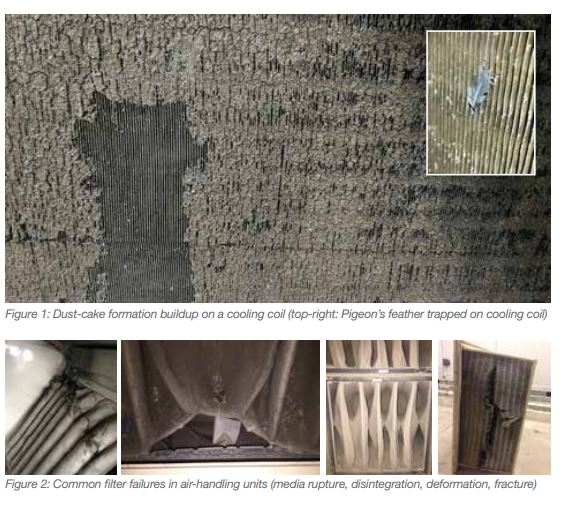We had it coming and could have mitigated the spread of COVID-19 with better building preparedness, says Dr Iyad Al-Attar, independent air filtration consultant

Several questions hover in the mind with a persistence that is unsettling. Since when has “our humanity”, empowered by science and technology, taken so long to defeat a virus? Is COVID-19 the narrative of how we are interacting with our environment and designing our so-called “smart buildings”? Was the pandemic the litmus test to following deficient HVAC, filtration and building standards?
I recall visiting an air-handling unit in a shopping mall, some years ago. The scenery was familiar: Collapsed air filters, primary filters washed to the point of destruction… and a pigeon’s feather trapped in the cooling coil (Figure 1). I wondered that if a pigeon’s feather is found on a cooling coil, what would stop microorganisms from invading the HVAC system and using it as a vehicle to transport themselves in the indoor environment? Clearly, microorganisms will always find an entry point in an exposed HVAC system, particularly those that have leaks and chronic filter failures, as shown in Figure 2.
In the past few decades, changes to our IAQ tactics were painfully slow, advances in HVAC technologies were on the slim side, air filtration was rather ignored; it is no surprise, then, that we find ourselves into the second year of battling COVID-19 – without complete success.

Dr Iyad Al-Attar
Enhancing IAQ is virtually impossible in the midst of exposed HVAC systems, leaky ducts and deficient/failing air filters. While filtration standards are always in demand, they are poorly understood, rarely followed and never applied assiduously. Using the same filter selections for all sorts of contaminant types, concentration and size distribution suggests that that we do not have an appropriate filtration plan in place.
To find the light at the seemingly never-ending Corona tunnel we find ourselves in, we need to get users, engineers and consultants to share objectives and responsibilities by employing all available maintenance measures and filtration technologies to attain the best IAQ possible.
But it is not only filtration. The air quality issues we are confronted with are clearly a manifestation of our environmental behaviour, the way we choose to condition the air, and the manner in which we ventilate and filter the air.
Let’s face it, environmentally speaking, we are running amuck, considering the increased concentration of particulate matter and gaseous contaminants emitted annually. Frankly, it is questionable whether or not existing filtration techniques alone are capable of accommodating such enormous increases in pollutant concentrations without addressing emission reduction.
In order to gain an intrinsic understanding of our status quo, we need to get out of the complacency mode we have been living in. For years, we have been singing the same songs about energy and sustainability and focusing mainly on obtaining indoor thermal comfort regardless of the air quality entertained as a result. Saving energy was, and possibly still is, the focal point of the decision making process. However, it overshadowed other critical issues in our priorities. Simply put, if air quality requires extra spending, we should do it.
However, that would require smart buildings, aerodynamic filter design and responsive HVAC systems that accommodate the variation in IAQ. For years, we have addressed energy single-handedly and asked the same questions about how to enhance IAQ. Such an approach did not take us far, and the dream of making significant advancements in IAQ disappeared into thin air as conventional washable filters, and the mindset that endorsed them, remained the driving force of filter acquisition.
Until today, washable filters were the champions of any filtration selection and the favourite toys of many maintenance managers. The addiction to washing and reusing filters has compromised any filtration upgrade plans and contributed to the deterioration of IAQ. Ideally, the optimum start to appropriately selecting air filters for a specific application is to characterise the contaminant types we are trying to capture, what their concentrations are, as well as their particle size distribution.
Ultimately, we come to realise the uniqueness of each application as soon as we admit they are all different and their HVAC systems operate under different climate conditions. Filtration is more than just pleating a flat media to increase the surface area of a filter, and it is not the only measure to enhance its efficiency. Efficient air filters need to be thought of as an integrated segment of the HVAC systems and the IAQ equation, not as a retrofit.
The efforts of reshuffling our priorities or working with what we have are yesterday’s tricks, and the pandemic has proven loud and clear that they constitute a wrong approach. What is required is recognising, establishing and redefining our real priorities. This is particularly important, as the efforts that were exerted in terms of reducing air pollution levels, enhancing IAQ and employing responsive HVAC systems to act simultaneously were modest at best, not to mention the non-existence of IAQ infrastructure and efficient filtration.
PULLING THE PLUG
We can no longer pull the socio-economic plug every time there is a hike in COVID cases. There have to be concrete measures to confront the current and future pandemics. Seeking lockdown as a safety measure to avoid the virus is not just the first idea we have had, but it seems to be our only idea to confront the hike in COVID cases. The truth of the matter is that we cannot run away and hide.
The fact that the narrative of ‘flight and refuge’ is so dominantly being played out is a damning testimony that we neither have the tools nor the conditions to confront the virus. While air filtration technologies can contribute to better IAQ, it is critical to realise that they do not constitute a standalone solution. Further, we need to revisit our conventional HVAC systems and outdated filtration selections, which were sought to protect us in the past decades but which have clearly failed to do so during the pandemic.
The paradox that defines the status quo of our air quality is that we desire to enhance our IAQ, but there is no infrastructure to work with in terms of filters, sensors and adaptive HVAC systems capable of responding to the IAQ changes.
Then comes the debate of whether or not the virus is airborne and whether or not it is indeed possible for it to be transported by HVAC ducting systems, amongst others. We have spent far more time trying to convince others of our answers to such questions and arguing over different perspectives than we are not acting in a preventative manner and assuming worst-case scenarios.
It is possible to act. It is possible to generate favourable results. It is high time we, for instance, dipped into the enormous pool of potential that renewable energy technologies represent. It is high time we adopted smart HVAC systems, air quality sensors, particulate and gaseous filtration, and aerosol monitoring, which represent the low-hanging fruit in the orchard of remedies to the poor IAQ challenges and enormous anthropogenic pollution.
THE EXPECTED FATE
The pandemic was the expected fate we had to face after decades of complacency and a clear manifestation of the way we have been polluting our environment through the horrendous ways we generate and use energy. Along with the global imperatives of climate change, the economic pressures of oil price hikes and resource depletion, global attention needs to be refocused on energy use, generation and environmental stewardship.
Issues such as urban and indoor quality were not even on the priority list just a short time ago. Integrated air quality solutions are frustrated by the complex structure and speed of the decision-making processes at all levels of government.
Does it come as a surprise that we are paying the penalties of doing nothing as far as granting air quality and filtration technologies their due attention? Air filter selections are usually the last aspects that come up for attention and attract investments. Therefore, it has come to a situation where everyone is at the mercy of their own filtration devices – that is, wearing a personal mask around the clock.
THE EMBERS OF PANDEMICS
In the midst of our air quality challenges, we had no qualms about allowing emissions to escalate. The scourge of air pollution that humanity faces today requires that we all pay close attention to how we urbanise, live and pollute our atmosphere. For decades, we thought we had all the air quality answers.
Today, the pandemic has forced us to ask different questions. The pain that future generations will inherit as a result of our being in “complacency mode” will lead to more pandemics, cities getting submerged, food supplies facing decimation, nations getting displaced and conflicts heading in the direction of escalation. Environmental agreements require far more than the ink used in signing them.
Our promise to the environment comes at a price. We must scale up our ambitions and follow through with appropriate actions. We must embrace the sense of urgency about bringing environmental agreements into force. Until pollution quests are answered, the embers of pandemics will continue to burn.
Copyright © 2006-2025 - CPI Industry. All rights reserved.